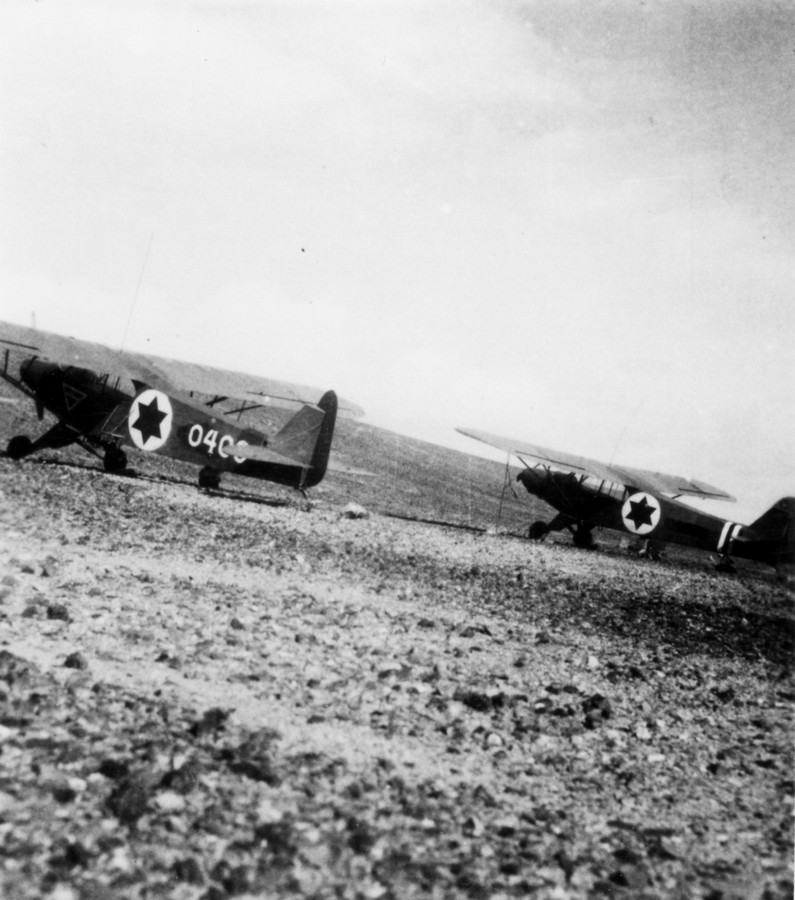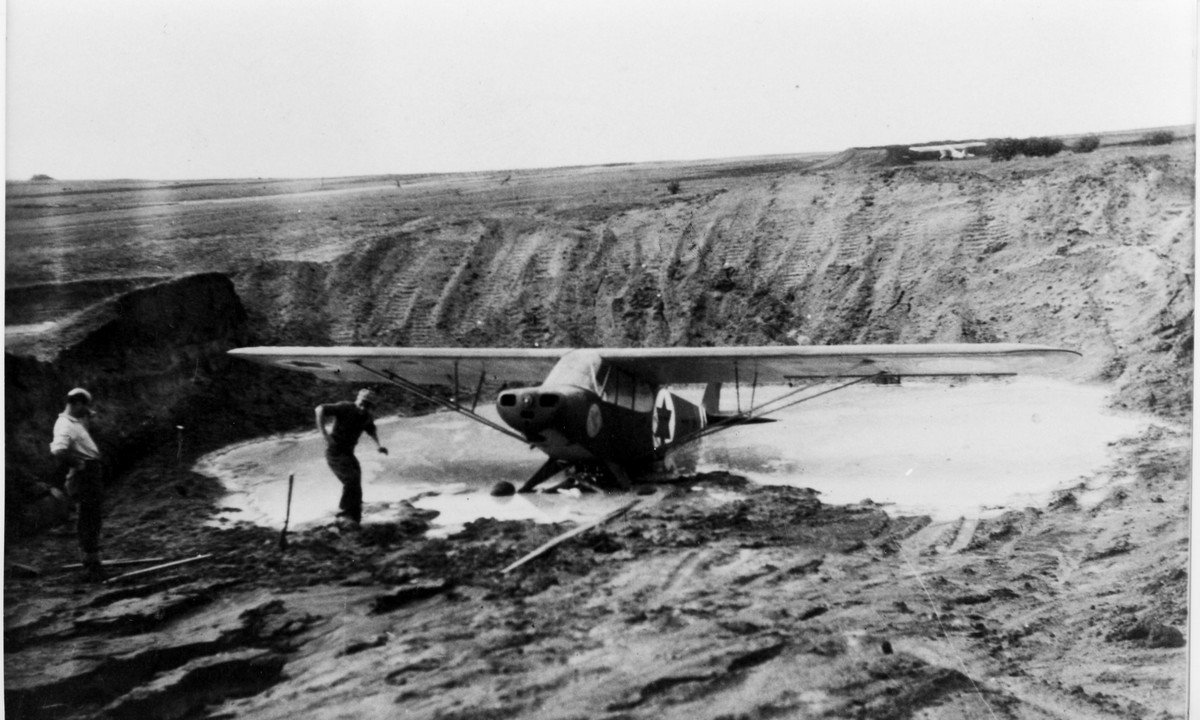The Negev Squadron
During the initial stages of hostilities, light aircraft were used for evacuating casualties, transporting mail, dropping ammunition and medical supplies, gathering intelligence and even for combat.
In the last 10 days of December 1947, the S.A. - Sheirut Avir, (Air- Service) later named, "The Israeli Air Force", performed 17 sorties, 14 of which were in the Negev and only three in other areas of the country. The aircraft operated from the S'de Dov airport in Tel Aviv and sometimes from the airport in Lod. In the middle of December 1947, the Sangav (Siyure Negev) - Negev Patrol order was issued, in which the planning procedures of the patrols as well as the contact between the ground forces and the aircraft, were charted.
In December 1947, the Sangav carried out 21 sorties – 50 flight hours. Soon, the Sangav began to operate daily flights to and from most of the settlements in the Negev. The settlements erected two poles, connected by a rope, to which the Outgoing Mail bag was attached. A light aircraft would arrive, dive low and drop newspapers and mail. It would then pull up the rope with the bag of outgoing mail, using an anchor-like device.
During that period Nevatim, a moshav settled by a group of 19 young men and 8 young women, was attacked. On 17.12.47, Nevatim was attacked by a band of 60 Arabs from Hebron and Beer Sheba. The attackers deployed at night in the wadi north-west of the moshav. In the morning, the members set out to start the water pump in the well, situated 250 meters north of the settlement, close to the wadi.. They were surprised by a gunfire attack and immediately retreated into the settlement without suffering any casualties. The Arabs then opened an attack on the settlement and two of the defenders were wounded. In the 2nd Battalion headquarters, they feared that Nevatim would not be able to hold out. A light plane – Auster (or Primus as it later became known) was on its way to bring a doctor to Revivim in order to treat the wounded who had been injured in an ambush next to the Bir-Asluji police station on the previous day. The pilot was diverted to Beit Eshel where a machine gunner equipped with grenades boarded the plane, and they flew in the direction of Nevatim. At Nevatim the pilot flew low and the machine gunner fired at the Arabs and also threw grenades. The attackers were caught by surprise and fled. When the fighting ended, a British army unit arrived at Nevatim and evacuated one of the wounded men to Beit Eshel. From there, in the same aircraft, he was transferred to Tel Aviv.
The British authorities warned that any Jewish plane using arms would be shot down. As a result, Yigal Yadin issued an order forbidding any bombing or firing from aircraft. In parallel, an Emergency Flight procedure was prepared for life-threatening situations.
Many flight hours were wasted in the daily flights to and from the Negev and it was decided to construct an airstrip in the Negev. The commanders of the Palmach headquarters approached the Chief of Staff with the suggestion that a landing strip be built at Nir-Am, with two planes in place. It was also suggested to stockpile an emergency store of ammunition and medical supplies at Nir-Am, packed and ready to drop on the isolated settlements, should the need arise. The suggestion was accepted and at the beginning of February an emergency base was established at Nir-Am, but the planes still continued to fly from Tel Aviv to the Negev. Prior to the Egyptian invasion, landing strips were built in almost all the Negev settlements. Landing strips for cargo planes were constructed at Revivim, Imra and next to Ruhama.
The need for effective cooperation between the HQ of the Air Service and the HQ of the Negev forces became evident. There were many problems and misunderstandings which stemmed from the increasing needs of the Negev for air support. Sangav sorties were often cancelled in accordance with the timetable and other considerations of the Air Services. The Negev Commander was upset and angry and a crisis erupted. On the 5th of February, Nahum Sarig held back two planes that had arrived too late to help in a battle, despite the fact that they were scheduled to return to S'de Dov. Urgent telegrams were sent, threatening sanctions on air support for the Negev. The Brigade Commander contacted Palmach headquarters and listed his complaints about the inefficiency of operating planes in the Negev from a Tel Aviv airport. After the intervention of Yadin, it was decided to operate a separate Air Service in the Negev with a squadron of two planes posted at the Nir-Am emergency airbase.
The commander of the first squadron was Ezer Weitzman and the pilots who served with him were: Eliyahu Feingrash (Eli Eyal), Yaakov Avishar and Nahum Birenbaum. The pilots and the Palmach fighters worked in close contact with each other and socially they were very compatible. The pilots based at Nir-Am flew the Negev Commanders back and forth, and were involved in some difficult situations in the Negev battles. They soon considered themselves Palmach members and were accepted as such by their Palmach comrades.
Owing to the heavy artillery shelling on Nir-Am after the Egyptian invasion, the squadron moved to Dorot where it remained and from where it operated until the end of the Yoav campaign. Later, they were transferred to the abandoned airfield built by the British next to Be'er Sheva. From there the squadron provided assistance and support for the ground forces until after the Horev operation. On 28.1.49, the Negev squadron was disbanded and the pilots were transferred to Squadron no.100 at the Ekron base.
In December 1947, the Sangav carried out 21 sorties – 50 flight hours. Soon, the Sangav began to operate daily flights to and from most of the settlements in the Negev. The settlements erected two poles, connected by a rope, to which the Outgoing Mail bag was attached. A light aircraft would arrive, dive low and drop newspapers and mail. It would then pull up the rope with the bag of outgoing mail, using an anchor-like device.
During that period Nevatim, a moshav settled by a group of 19 young men and 8 young women, was attacked. On 17.12.47, Nevatim was attacked by a band of 60 Arabs from Hebron and Beer Sheba. The attackers deployed at night in the wadi north-west of the moshav. In the morning, the members set out to start the water pump in the well, situated 250 meters north of the settlement, close to the wadi.. They were surprised by a gunfire attack and immediately retreated into the settlement without suffering any casualties. The Arabs then opened an attack on the settlement and two of the defenders were wounded. In the 2nd Battalion headquarters, they feared that Nevatim would not be able to hold out. A light plane – Auster (or Primus as it later became known) was on its way to bring a doctor to Revivim in order to treat the wounded who had been injured in an ambush next to the Bir-Asluji police station on the previous day. The pilot was diverted to Beit Eshel where a machine gunner equipped with grenades boarded the plane, and they flew in the direction of Nevatim. At Nevatim the pilot flew low and the machine gunner fired at the Arabs and also threw grenades. The attackers were caught by surprise and fled. When the fighting ended, a British army unit arrived at Nevatim and evacuated one of the wounded men to Beit Eshel. From there, in the same aircraft, he was transferred to Tel Aviv.
The British authorities warned that any Jewish plane using arms would be shot down. As a result, Yigal Yadin issued an order forbidding any bombing or firing from aircraft. In parallel, an Emergency Flight procedure was prepared for life-threatening situations.
Many flight hours were wasted in the daily flights to and from the Negev and it was decided to construct an airstrip in the Negev. The commanders of the Palmach headquarters approached the Chief of Staff with the suggestion that a landing strip be built at Nir-Am, with two planes in place. It was also suggested to stockpile an emergency store of ammunition and medical supplies at Nir-Am, packed and ready to drop on the isolated settlements, should the need arise. The suggestion was accepted and at the beginning of February an emergency base was established at Nir-Am, but the planes still continued to fly from Tel Aviv to the Negev. Prior to the Egyptian invasion, landing strips were built in almost all the Negev settlements. Landing strips for cargo planes were constructed at Revivim, Imra and next to Ruhama.
The need for effective cooperation between the HQ of the Air Service and the HQ of the Negev forces became evident. There were many problems and misunderstandings which stemmed from the increasing needs of the Negev for air support. Sangav sorties were often cancelled in accordance with the timetable and other considerations of the Air Services. The Negev Commander was upset and angry and a crisis erupted. On the 5th of February, Nahum Sarig held back two planes that had arrived too late to help in a battle, despite the fact that they were scheduled to return to S'de Dov. Urgent telegrams were sent, threatening sanctions on air support for the Negev. The Brigade Commander contacted Palmach headquarters and listed his complaints about the inefficiency of operating planes in the Negev from a Tel Aviv airport. After the intervention of Yadin, it was decided to operate a separate Air Service in the Negev with a squadron of two planes posted at the Nir-Am emergency airbase.
The commander of the first squadron was Ezer Weitzman and the pilots who served with him were: Eliyahu Feingrash (Eli Eyal), Yaakov Avishar and Nahum Birenbaum. The pilots and the Palmach fighters worked in close contact with each other and socially they were very compatible. The pilots based at Nir-Am flew the Negev Commanders back and forth, and were involved in some difficult situations in the Negev battles. They soon considered themselves Palmach members and were accepted as such by their Palmach comrades.
Owing to the heavy artillery shelling on Nir-Am after the Egyptian invasion, the squadron moved to Dorot where it remained and from where it operated until the end of the Yoav campaign. Later, they were transferred to the abandoned airfield built by the British next to Be'er Sheva. From there the squadron provided assistance and support for the ground forces until after the Horev operation. On 28.1.49, the Negev squadron was disbanded and the pilots were transferred to Squadron no.100 at the Ekron base.

















